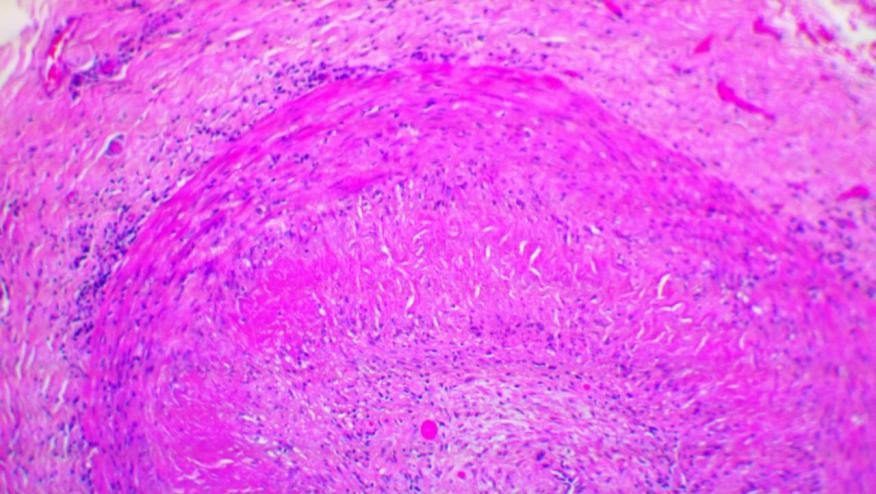GCA: Uptick in Severe Infections in First Year Save

Patients with giant cell arteritis (GCA) had a higher rate of severe infections compared with the general population, a French study found.
During the first year after GCA was diagnosed, the incidence rate of infections resulting in hospitalization was 11.1 per 100 patient-years versus 5.9 per 100 among controls, according to Jean Schmidt, MD, PhD, of Amiens University Hospital in Amiens, and colleagues.
Accordingly, the incidence rate ratio for severe infection was 2.1 (95% CI 1.2-3.4), the researchers reported online in Arthritis & Rheumatology.
GCA is the most common type of vasculitis. It develops in older patients and affects medium and large-sized arteries. Corticosteroid treatment dramatically suppresses the symptoms of GCA and can prevent the ocular complications, but adverse effects, including life-threatening infections, can occur.
Efforts to identify steroid-sparing treatments have had only limited success. Methotrexate has shown modest benefits, but tumor necrosis factor inhibitors such as infliximab (Remicade) have not been effective.
The study included 486 patients diagnosed with GCA from 1991 to 2009, drawn from 40 centers in France. Almost 75% were women, and mean age was 74. Age- and sex-matched controls were recruited from the representative city of Saint Etienne.
Participants were followed every 6 months for about 5 years. At each visit, clinicians collected information on infections, corticosteroid dose, and other relevant data.
Patients who developed severe infections were older at baseline (77 versus 74 years,P<0.0001).
During the first year after diagnosis, septic shock and colitis were significantly more common among GCA patients (P=0.03). Pneumonia and pyelonephritis also occurred more often, and four GCA patients developed tuberculosis.
"Close clinical monitoring, early antibiotic treatment, and specific screening for tuberculosis before treatment may be ways to reduce severe infections in patients with CGA," the authors wrote.
The researchers also considered whether mortality among GCA patients changed during the years of the study, and found that in the earlier period, before 1997, overall mortality was increased in patients with GCA (HR 2.4, 95% CI 1.5-3.9,P=0.0002). After Jan. 1, 1997, overall mortality was similar among patients and controls.
"This improvement may reflect better care or a change in the severity of the disease in the recruited patients," the authors noted.
In a multivariate model adjusting for age at inclusion and the period of enrollment, the factors associated with overall mortality were a diagnosis of GCA (HR 2.22, 95% CI 1.54-3.21,P<0.0001), severe infection (HR 2.14, 95% CI 1.49-3.06,P<0.0001), and a diagnosis of cancer during follow-up (HR 2.08, 95% CI 1.30-3.33,P=0.0022).
"Surprisingly," gender was not a risk factor for all-cause mortality in this study. "The size and the length of follow-up of our study were probably too limited to show a difference between women and men," Schmidt and colleagues wrote.
Infections were the cause of death in 28% of GCA patients compared to 6.5% of deaths in the general population.
Mortality caused by an infection was especially increased in GCA patients with diabetes, which can be worsened or induced by corticosteroid therapy (HR 3.3, 95% CI 1.4-7.7,P=0.006) and in those requiring more than 10 mg/day of steroids after a year of treatment (HR 4.61, 95% CI 1.38-15.36,P=0.0127).
The influence of corticosteroids on infection risk is complex, the authors explained, and can involve decreased proliferation and migration of lymphocytes, impaired cellular immune responses and neutrophil adhesion, and cytokine inhibition. The use of steroids also could delay diagnosis of infections in this elderly population who may have fewer systemic symptoms such as fever.
"These data underscore the importance of identifying newer treatments for GCA that would reduce or eliminate the use of corticosteroids," said Kenneth J. Warrington, MD, of the Mayo Clinic in Rochester, Minn., who was not involved in the study.
One such approach being investigated is interleukin-6 inhibition with tocilizumab (Actemra).
"The study adds to the growing literature regarding complications that are seen in patients with GCA, and the importance of better and safer treatments," Warrington toldMedPage Today.
Although the study "does alert providers to be vigilant for infections in patients with GCA," it is not likely to have a significant immediate impact on clinical practice, he said. Nonetheless, because the clinical characteristics of the study participants were similar to those of GCA patients elsewhere, the findings "should be generalizable to the U.S. population," he added.
A possible study limitation was that the patients and controls weren't drawn from the same population.
Schmidt and co-authors disclosed no relevant relationships with industry.
This article brought to RheumNow by our friends at MedPage Today. It was originally published on February 3, 2016.










If you are a health practitioner, you may Login/Register to comment.
Due to the nature of these comment forums, only health practitioners are allowed to comment at this time.